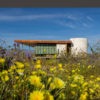A man’s home is his castle, and so is his castle. These two building types excepted, architecture typically brings people together, rather than keeping them apart. Some people say the first work of architecture was the painted cave, “shelter with decoration on it,” in Venturi, Scott Brown, and Izenour’s terms. But others would say it was the rug spread on the ground by a merchant to display his or her wares, a neutral gathering place around which antagonistic tribes would suspend their animosities.
One thing about that rug—as about any building—is that it is not abstract but concrete. Whatever the benefits of virtual space, it is characterized by interpersonal abstraction—or anonymity, which is the same thing—making anger easy. Witness road rage, or e-mail flaming. Or presidential campaigns.
You may have noticed that, in the recent election coverage, commentators offered opposing predictions for President Bush’s second term. Some—including Willie Brown—suggest that a lame-duck president, even with his own party controlling Congress and the Supreme Court, cannot afford to perpetuate the current polarization of the American electorate, at least not if he hopes to secure in history a favorable judgment. Others counter that divisiveness has worked fine for the administration so far, and we may expect the President to “stay the course” in this as in all else. I will suggest that who turns out to be correct will depend not insignificantly on how the President moves about the built world.
I have taught at both Rhode Is land School of Design and California College of the Arts, schools with nearly identical offerings and structures. Both are terrific schools. But they differ dramatically in at least one way: at RISD, almost every department has its own building; at CCA, the architecture and design departments, along with many fine artists, are all bungled up together in more-or-less open studios. Not surprisingly, inter-disciplinary exposure and understanding are greater at CCA.
As an architect, I believe that any rapprochement between the parties and the frightfully divided country they represent will require that the President spend a lot of time in rooms with Democrats. Because I’ve noticed that even I find it hard to dislike Republicans when I encounter them face-to-face, whereas at a distance even the sweetest among them are barely tolerable. No doubt the converse is true, as well.
Now, I realize that being in the same space does not guarantee friendly relations. It’s probably a good idea, for instance, for Israel to excuse itself from the Gaza Strip; and things can get pretty coarse even on the floor of the U.S. Senate. But we are gregarious creatures, and we’re more likely to maintain friendships—or at least a sense of one another’s humanity—over a cup of espresso or a glass of beer, through the clasping of hands, by gathering in spaces that have become places through the magic of architecture—than over a T-1 line. Which is why buildings are important.
A couple of other notes. First, two fine, new books have come in over the transom. One is Mitchell Schwarzer’s lively exploration, Zoomscape: Architecture in Motion and Media (New York: Princeton Architectural Press, 2004). The second, which could alternatively be subtitled “Architecture in Stasis and Stone,” is Steven & Cathi House’s beautiful Mediterranean Villages: an Architectural Journey, with Luci Ferrari and James P. Warfield (New York: Images Publishing, 2004). Check ‘em out.
Finally, a word of thanks to Carol Shen, FAIA, who is completing a much-extended term as chair of the arcCA editorial board. Carol has done a fabulous job of seeing us through the transition to the current format, mustering energy, ideas, and support with a panache that is hers alone. Thank you, Carol.
Originally published in 4th quarter 2004, in arcCA 04.4, “School Daze.”





